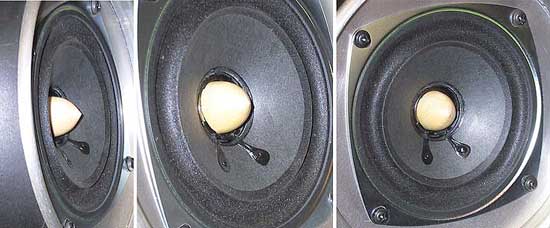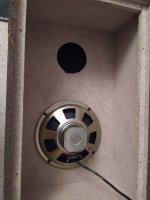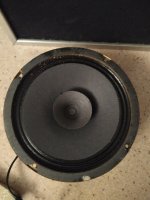Lovely. What was the layer used between the two layers of wood? Thanks.Double wall constrained layer damping cabs, very pleased with the results!
Larry
I used this product from Home Hardware, https://www.homehardware.ca/en/300m...c-caulking/p/2034952?page=search-results page
Acrylic Caulking compound? Wow! Thanks. Who would have thought?I used this product from Home Hardware, https://www.homehardware.ca/en/300ml-brown-35-year-all-purpose-acrylic-caulking/p/2034952?page=search-results page
Raw, but have some musicality...
May be used as sort of WaW with a woofer at the bottom and the tweeter at the top. Seems like they may benefit from the phase plug (I tend to hear some nasal sound, which I found is often ameliorated with the phase plug)...
If nothing works, back to junk...
(They are around 5.5" diamater)
May be used as sort of WaW with a woofer at the bottom and the tweeter at the top. Seems like they may benefit from the phase plug (I tend to hear some nasal sound, which I found is often ameliorated with the phase plug)...
If nothing works, back to junk...
(They are around 5.5" diamater)
Last edited by a moderator:
I have yet to run into a whizzer cone that does not benefit from phase plugs. The small VC suggests limited bass but top end potential.
A coat of modPodge/Puzzlekoat would not hurt, 98¢ tweak, GM’s massge the edge of the whizzer. Some ZIG q1-way glue on the top/back lip of the whizzer. Surround/surround-cone interface might benefit as well.
With a similar set of dirt cheap 8s i found a Henry Kloss style RLC midrange suppressin filter also helps, i suspect this is aimed at voice.
dave
A coat of modPodge/Puzzlekoat would not hurt, 98¢ tweak, GM’s massge the edge of the whizzer. Some ZIG q1-way glue on the top/back lip of the whizzer. Surround/surround-cone interface might benefit as well.
With a similar set of dirt cheap 8s i found a Henry Kloss style RLC midrange suppressin filter also helps, i suspect this is aimed at voice.
dave
Last edited:
Nasal sound is often a result of missing ventilation of the air cussion below the dust cap. Just try first to make a hole in the middle of the dust cap of approximately 1-3 mm with a scalpel knife. (Fostex alike) Or take a needle and put six to ten holes in the dustcap at its side close to the whizzer cone where the dustcap is more stable and will not bend under the pressure of the needle. The perforation may help remedy escape the air of being compressed. Very cheap drivers have usually no ventilation at all (perforation of the voice coil Or hole in the dustcap OR ventilation of the pole piece)
Last edited by a moderator:
Nasal sound is often a result of missing ventilation of the air cussion below the dust cap.
Yes. Described as an “oil can” resonance. Our first lipstick cap phase plugs were a (successful) quest to kill that characteristic of the RS 40-1197. Wood versions were the first planset10-hifi product.

dave
These speakets will present a nice opportunity to practice the mods, without fear of an expensive damage 😉
Would replacing the shallow dome of the dust cap with a pointy paper cone, glued (PVA ?) to the whizzer cone work? I presume that the wooden phase plugs are glued to the centre pole piece.
Removing the dustcap means also to loose some square centimeters of radiating surface of small drivers. I try to keep the dustcap whenever possible.
Would replacing the shallow dome of the dust cap with a pointy paper cone, glued (PVA ?) to the whizzer cone work? I presume that the wooden phase plugs are glued to the centre pole piece.
Will lower the frequency of the oil can resonasnce. Our phase plugs attach to the pole piece magnetically so they are removable.
dave
Last edited:
Removing the dustcap means also to loose some square centimeters of radiating surface of small drivers. I try to keep the dustcap whenever possible.
in this one it does not look near that large. Everything is a compromise. An 8" FR already has a large amount of cone, and its issues will be at the HF.
dave
Right, all of a typical wide range driver's HF (2 kHz-up) is off the DC if no whizzer and vice versa.Removing the dustcap means also to loose some square centimeters of radiating surface of small drivers. I try to keep the dustcap whenever possible.
Hmm. I had thought of using GreenGlue. I wonder if it would work the same.I used this product from Home Hardware, https://www.homehardware.ca/en/300ml-brown-35-year-all-purpose-acrylic-caulking/p/2034952?page=search-results page
- Home
- Loudspeakers
- Full Range
- Full Range Speaker Photo Gallery

